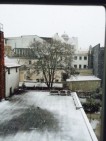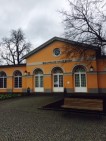Our days in Weimar were marked by blustering winds, rain, and even a little snow, and we spent them exploring various parts of the city that spoke to its history. Weimar’s history is evident everywhere you go, but as with all cities in Germany its history is complex and its memories reveal past sins. Weimar was the site of the doomed Weimar Republic, Germany’s attempt at democracy following its complete political and economic defeat after World War I. During the Weimar Republic, German culture thrived and the avant-garde was able to flourish. It was at this time that the Bauhaus School, led by Walter Gropius, began in 1919. The Bauhaus School revolutionized the face of form and functionality in the Arts, but it was forced into shuttering its windows when the NSDAP (Nazi) Party came into power. On our first day we withstood the brisk wind and rain to observe a museum dedicated to the Bauhaus and discuss its significance.
Weimar is a beautiful city, with typical cobblestone walkways, known as Kopfsteinpflaster in the German language, which lead you through wide-open squares and intimate paths. It is a quiet city; people don’t speak loudly here and when you walk at night you’ll find that the streets are filled with heavy silences. Weimar isn’t Berlin or Vienna, where the traffic never stops and you can find a café on any street corner humming with a consistent buzz of conversation. After World War II it was a part of the East German state, the German Democratic Republic known as the Deutsche Demokratische Republik (DDR), and the legacy of Soviet influence survives to this day. Freedoms were greatly limited behind the Iron Curtain and an atmosphere of tension and hushed tones proves hard to eliminate in Weimar.
Despite all that Weimar has been through in the 20th century, it is still regarded as a symbolic cultural capital of Germany. A literary titan who is proudly associated with Weimar is Johann Wolfgang von Goethe. Our study group was lucky to have the chance to visit his home and a museum dedicated in his honor, and we understood a little bit more why Goethe is worshipped as a German cultural hero. His colleague, and another literary great, was Friedrich Schiller. Along with Goethe, Schiller resided in Weimar, and these two men lend their names to define Weimar as one of Germany’s most important cultural and historical cities.
- Weimar Was Snowy!
- View from a Memorial Honoring Fallen Soviet Soldiers
- Bauhaus School Museum





